| View previous topic :: View next topic |
| Author |
Message |
Doc Sharptail


Joined: 23 Nov 2020
Posts: 1216
Location: Winnipeg Canada
|
 Posted: Fri Feb 03, 2023 5:21 am Post subject: Posted: Fri Feb 03, 2023 5:21 am Post subject: |
 |
|
Doc Sharptail wrote:
| KEO wrote: |
A very versatile lens indeed, and it works well on my GFX with some vignetting only in certain situations, mainly landscape or macro shooting. Macro works great (no vignetting) with extension tubes though. |
Show some sample shots when you get the time.
How many blades on the aperture?
-D.S.
_________________
D-810, F2, FTN.
35mm f2 O.C. nikkor
50 f2 H nikkor, 50 f 1.4 AI-s, 135 f3.5 Q,
50 f2 K nikkor 2x, 28-85mm f3.5-4.5 A/I-s, 35-105 3.5-4.5 A/I-s, 200mm f4 Micro A/I, partial list.
"Ain't no half-way" -S.R.V.
"Oh Yeah... Alright" -Paul Simon |
|
| Back to top |
|
 |
calvin83


Joined: 12 Apr 2009
Posts: 7584
Location: Hong Kong
|
 Posted: Sun Feb 05, 2023 3:10 am Post subject: Posted: Sun Feb 05, 2023 3:10 am Post subject: |
 |
|
calvin83 wrote:
I can test my lens coverage on 44x33mm now. 
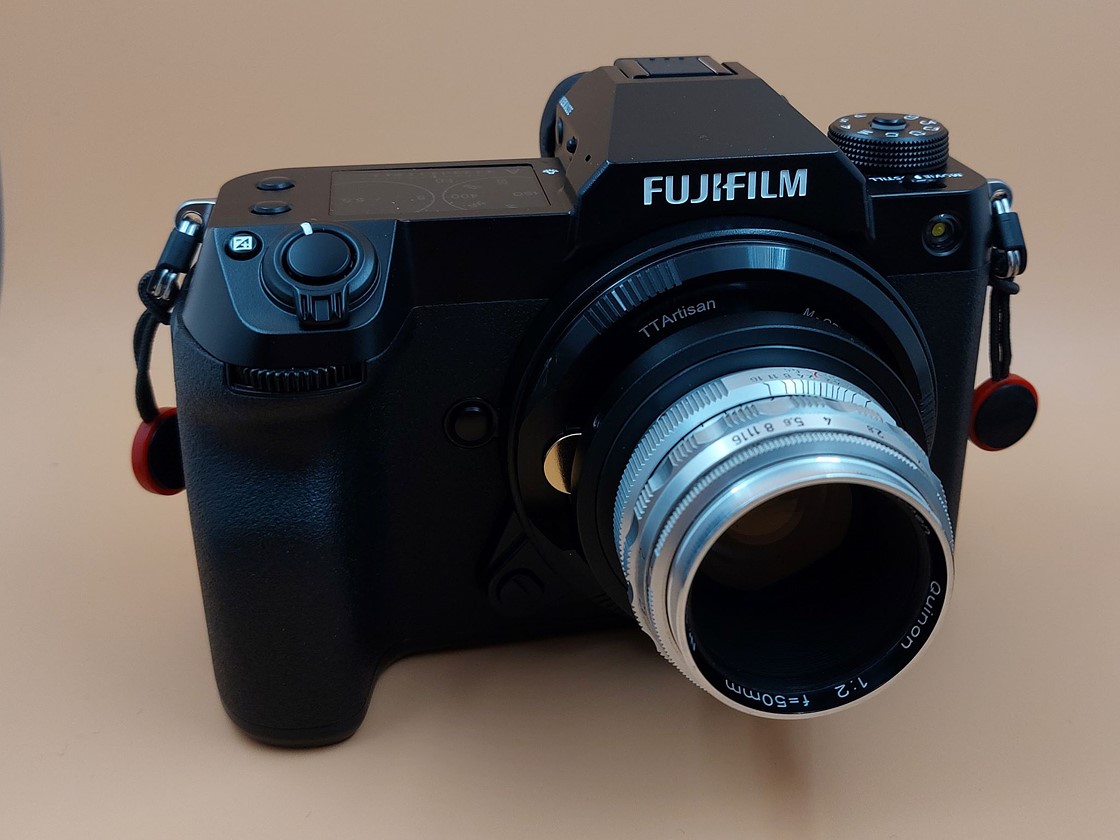
The sunken mount Quinon 50/2 seems have pretty good coverage on GFX despite the small rear element. On 16:9 is it pretty useable especially at portrait distance.
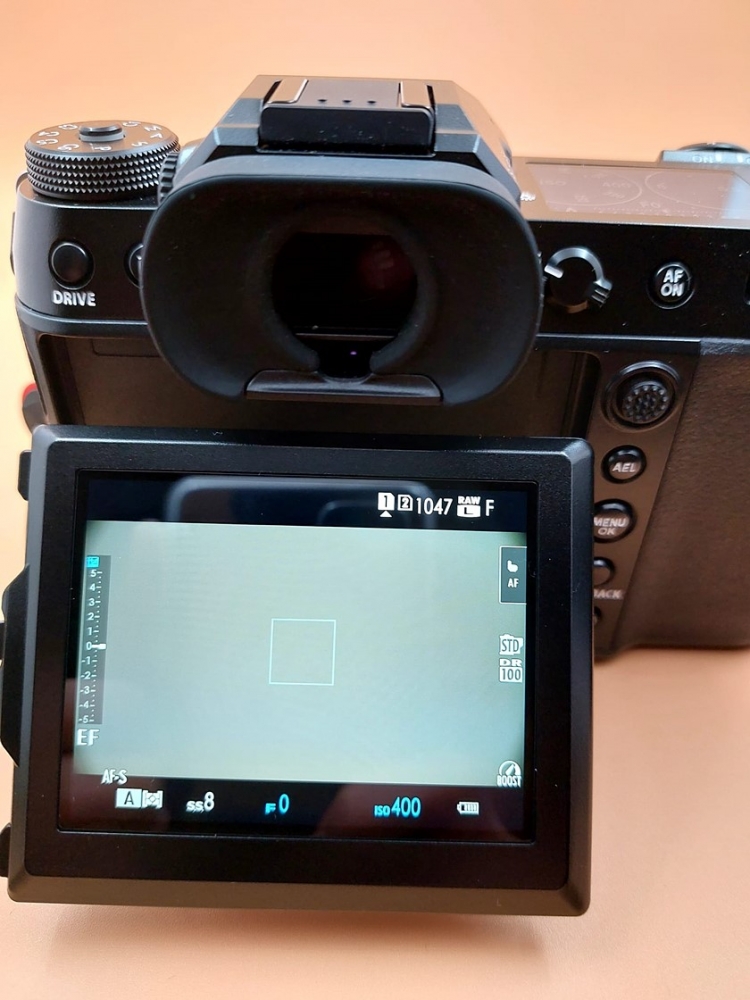
_________________
The best lens is the one you have with you.
https://lensfever.com/
https://www.instagram.com/_lens_fever/ |
|
| Back to top |
|
 |
visualopsins


Joined: 05 Mar 2009
Posts: 11063
Location: California
Expire: 2025-04-11
|
 Posted: Sun Feb 05, 2023 3:16 am Post subject: Posted: Sun Feb 05, 2023 3:16 am Post subject: |
 |
|
visualopsins wrote:
| calvin83 wrote: |
I can test my lens coverage on 44x33mm now. 
The sunken mount Quinon 50/2 seems have pretty good coverage on GFX despite the small rear element. On 16:9 is it pretty useable especially at portrait distance. |
   
_________________
☮☮☮☮☮☮☮☮☮☮☮☮☮☮☮☮☮☮☮☮☮☮☮☮☮☮☮☮☮☮☮☮ like attracts like! ☮☮☮☮☮☮☮☮☮☮☮☮☮☮☮☮☮☮☮☮☮☮☮☮☮☮☮☮☮☮☮☮
Cameras: Sony ILCE-7RM2, Spotmatics II, F, and ESII, Nikon P4
Lenses:
M42 Asahi Optical Co., Takumar 1:4 f=35mm, 1:2 f=58mm (Sonnar), 1:2.4 f=58mm (Heliar), 1:2.2 f=55mm (Gaussian), 1:2.8 f=105mm (Model I), 1:2.8/105 (Model II), 1:5.6/200, Tele-Takumar 1:5.6/200, 1:6.3/300, Macro-Takumar 1:4/50, Auto-Takumar 1:2.3 f=35, 1:1.8 f=55mm, 1:2.2 f=55mm, Super-TAKUMAR 1:3.5/28 (fat), 1:2/35 (Fat), 1:1.4/50 (8-element), Super-Multi-Coated Fisheye-TAKUMAR 1:4/17, Super-Multi-Coated TAKUMAR 1:4.5/20, 1:3.5/24, 1:3.5/28, 1:2/35, 1:3.5/35, 1:1.8/85, 1:1.9/85 1:2.8/105, 1:3.5/135, 1:2.5/135 (II), 1:4/150, 1:4/200, 1:4/300, 1:4.5/500, Super-Multi-Coated Macro-TAKUMAR 1:4/50, 1:4/100, Super-Multi-Coated Bellows-TAKUMAR 1:4/100, SMC TAKUMAR 1:1.4/50, 1:1.8/55
M42 Carl Zeiss Jena Flektogon 2.4/35
Contax Carl Zeiss Vario-Sonnar T* 28-70mm F3.5-4.5
Pentax K-mount SMC PENTAX-A ZOOM 1:3.5 35~105mm, SMC PENTAX ZOOM 1:4 45~125mm
Nikon Micro-NIKKOR-P-C Auto 1:3.5 f=55mm, NIKKOR-P Auto 105mm f/2.5 Pre-AI (Sonnar), Micro-NIKKOR 105mm 1:4 AI, NIKKOR AI-S 35-135mm f/3,5-4,5
Tamron SP 17mm f/3.5 (51B), Tamron SP 17mm f/3.5 (151B), SP 500mm f/8 (55BB), SP 70-210mm f/3.5 (19AH)
Vivitar 100mm 1:2.8 MC 1:1 Macro Telephoto (Kiron)
|
|
| Back to top |
|
 |
kds315*


Joined: 12 Mar 2008
Posts: 16664
Location: Weinheim, Germany
Expire: 2021-03-09
|
 Posted: Mon Feb 06, 2023 8:18 am Post subject: Posted: Mon Feb 06, 2023 8:18 am Post subject: |
 |
|
kds315* wrote:
   WOW you went big format now Calvin!! WOW you went big format now Calvin!!
_________________
Klaus - Admin
"S'il vient a point, me souviendra" [Thomas Bohier (1460-1523)]
http://www.macrolenses.de for macro and special lens info
http://www.pbase.com/kds315/uv_photos for UV Images and lens/filter info
https://www.flickr.com/photos/kds315/albums my albums using various lenses
http://photographyoftheinvisibleworld.blogspot.com/ my UV BLOG
http://www.travelmeetsfood.com/blog Food + Travel BLOG
https://galeriafotografia.com Architecture + Drone photography
Currently most FAV lens(es):
X80QF f3.2/80mm
Hypergon f11/26mm
ELCAN UV f5.6/52mm
Zeiss UV-Planar f4/60mm
Zeiss UV-Planar f2/62mm
Lomo Уфар-12 f2.5/41mm
Lomo Зуфар-2 f4.0/350mm
Lomo ZIKAR-1A f1.2/100mm
Nikon UV Nikkor f4.5/105mm
Zeiss UV-Sonnar f4.3/105mm
CERCO UV-VIS-NIR f1.8/45mm
CERCO UV-VIS-NIR f4.1/94mm
CERCO UV-VIS-NIR f2.8/100mm
Steinheil Quarzobjektiv f1.8/50mm
Pentax Quartz Takumar f3.5/85mm
Carl Zeiss Jena UV-Objektiv f4/60mm
NYE OPTICAL Lyman-Alpha II f1.1/90mm
NYE OPTICAL Lyman-Alpha I f2.8/200mm
COASTAL OPTICS f4/60mm UV-VIS-IR Apo
COASTAL OPTICS f4.5/105mm UV-Micro-Apo
Pentax Ultra-Achromatic Takumar f4.5/85mm
Pentax Ultra-Achromatic Takumar f5.6/300mm
Rodenstock UV-Rodagon f5.6/60mm + 105mm + 150mm
|
|
| Back to top |
|
 |
calvin83


Joined: 12 Apr 2009
Posts: 7584
Location: Hong Kong
|
 Posted: Mon Feb 06, 2023 11:22 am Post subject: Posted: Mon Feb 06, 2023 11:22 am Post subject: |
 |
|
calvin83 wrote:
| visualopsins wrote: |
| calvin83 wrote: |
I can test my lens coverage on 44x33mm now. 
The sunken mount Quinon 50/2 seems have pretty good coverage on GFX despite the small rear element. On 16:9 is it pretty useable especially at portrait distance. |
    |

| kds315* wrote: |
   WOW you went big format now Calvin!! WOW you went big format now Calvin!! |
The camera is a shared equipment. I can use it when no one else booked it.
_________________
The best lens is the one you have with you.
https://lensfever.com/
https://www.instagram.com/_lens_fever/ |
|
| Back to top |
|
 |
KEO


Joined: 27 Sep 2018
Posts: 775
Location: USA
|
 Posted: Mon Feb 06, 2023 8:07 pm Post subject: Posted: Mon Feb 06, 2023 8:07 pm Post subject: |
 |
|
KEO wrote:
| Doc Sharptail wrote: |
| KEO wrote: |
A very versatile lens indeed, and it works well on my GFX with some vignetting only in certain situations, mainly landscape or macro shooting. Macro works great (no vignetting) with extension tubes though. |
Show some sample shots when you get the time.
How many blades on the aperture?
-D.S. |
Referring to the Tokina 90mm AT-X f/2.5 macro on the GFX 50SII...
8 bladed aperture.
My location is a frozen wasteland right now, but I managed to get a couple quick test shots.
Here's one extreme: a landscape at f/8. You'll notice faint shadows in the corners, which is not really a problem for me, but it might be for some.

Here's another extreme: minimum focus distance/maximum magnification at f/16. If the aperture were wide open the vignetting would be the same size but much softer. Obviously this is not ideal, but if you're shooting macro you can crop too. Like I said, I add extension tubes to get even closer and the vignetting disappears.

Finally a portrait of my dog. Just kidding, he's actually a cat.

I was sitting at my desk and he was about 50cm to 60cm away. The aperture was wide open. There's some soft vignetting, but this disappears as the distance increases. Above 70cm there's no more vignetting. I've taken several portraits at about 1m and they look perfect.
The lens is excellent. The only big downside is that I'll probably continue to use my 85mm f/2 AiS Nikkor 90% of the time over this one, simply because that lens is astoundingly good on the GFX and has no vignetting at all in any situation. The Tokina definitely has beautiful bokeh and a different character going for it though. |
|
| Back to top |
|
 |
Doc Sharptail


Joined: 23 Nov 2020
Posts: 1216
Location: Winnipeg Canada
|
 Posted: Mon Feb 06, 2023 9:28 pm Post subject: Posted: Mon Feb 06, 2023 9:28 pm Post subject: |
 |
|
Doc Sharptail wrote:
| KEO wrote: |
| Doc Sharptail wrote: |
| KEO wrote: |
A very versatile lens indeed, and it works well on my GFX with some vignetting only in certain situations, mainly landscape or macro shooting. Macro works great (no vignetting) with extension tubes though. |
Show some sample shots when you get the time.
How many blades on the aperture?
-D.S. |
Referring to the Tokina 90mm AT-X f/2.5 macro on the GFX 50SII...
8 bladed aperture.
My location is a frozen wasteland right now, but I managed to get a couple quick test shots.
Here's one extreme: a landscape at f/8. You'll notice faint shadows in the corners, which is not really a problem for me, but it might be for some.
Here's another extreme: minimum focus distance/maximum magnification at f/16. If the aperture were wide open the vignetting would be the same size but much softer. Obviously this is not ideal, but if you're shooting macro you can crop too. Like I said, I add extension tubes to get even closer and the vignetting disappears.
Finally a portrait of my dog. Just kidding, he's actually a cat.
I was sitting at my desk and he was about 50cm to 60cm away. The aperture was wide open. There's some soft vignetting, but this disappears as the distance increases. Above 70cm there's no more vignetting. I've taken several portraits at about 1m and they look perfect.
The lens is excellent. The only big downside is that I'll probably continue to use my 85mm f/2 AiS Nikkor 90% of the time over this one, simply because that lens is astoundingly good on the GFX and has no vignetting at all in any situation. The Tokina definitely has beautiful bokeh and a different character going for it though. |
We just came through another of those ten day long cold snaps- about 28F here now, and not too bad.
This overcast stuff has been around a lot lately, and sure can flatten a landscape.
Looks like a decent lens from here, and I will keep an eye out for one along the way.
Thanks for sharing your images!
-D.S.
_________________
D-810, F2, FTN.
35mm f2 O.C. nikkor
50 f2 H nikkor, 50 f 1.4 AI-s, 135 f3.5 Q,
50 f2 K nikkor 2x, 28-85mm f3.5-4.5 A/I-s, 35-105 3.5-4.5 A/I-s, 200mm f4 Micro A/I, partial list.
"Ain't no half-way" -S.R.V.
"Oh Yeah... Alright" -Paul Simon |
|
| Back to top |
|
 |
stevemark

Joined: 29 Apr 2011
Posts: 4088
Location: Switzerland
|
 Posted: Sat Feb 11, 2023 5:17 pm Post subject: Posted: Sat Feb 11, 2023 5:17 pm Post subject: |
 |
|
stevemark wrote:
Some mixed stuff from the local photo dealer - everything for free ... I hadn't been there for a few weeks, met one of their guys in town and he said he had set aside some Minolta stuff for me (knowing my connection to Minolta).
Well, here we go:
First very well preserved Minolta HiMatic 9, the very best of the classic Minolta rangefinders with built-in lens:
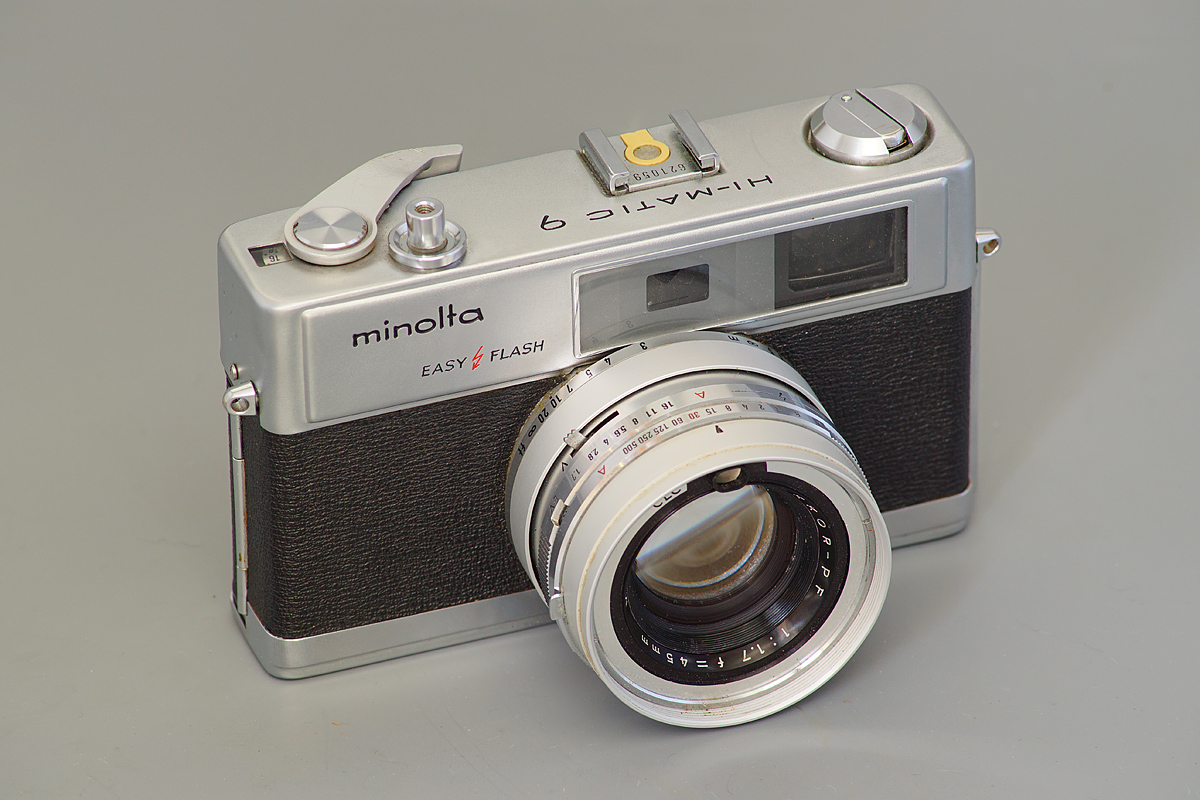
The camera is in fully working condition, which is rather unusual; even the long exposures are working fine (1 s and 1/2s). Whether the rangefinder still is adjusted correctly I don't know (yet), of course; at least it looks clear, and both images are clearly visible. The HiMatic 9 is unusual since it has an M mode (manual), an A mode (aperture priority AE) and an S mode (shutter priority AE). Shutter speeds go from 1s to 1/500s, and the aperture from f1.7 to f16. The lens is a Rokkor-PF 1.7/45mm, thus a [6/5] design. I would expect it to be at least as good as the contemporary Rokkor PF 1.7/55mm for the SR-T SLR.
The HiMatic 9 - because of the number "9" - fits well in the later series of professional Minolta SLRs such as the 9000, the 9xi, the Alpha (Dynax) 9 and even the Sony Alpha 900 (which was based on the never released Minolta "Dynax 9D").
Speaking of the "Dynax 9D": Here's the Minolta Dynax 7D, Minoltas first "real" DSLR. I got this one - also for free - with the attached Minolta AF 2.8/28-70mm G lens. The "G" series was Minoltas answer to the Canon "L" series, and for sure it was as good as the Canon L lineup, if not better. I have both the Minolta and the contemporary Canon 2.8/24-70mm L. The latter feels more "plasticky", while the Minolta is extremely well built. Since the Minolta has neither an AF- nor an aperture motor, it is pretty indestructible (unlike the Canons which tend to have problems with their USM or the aperture motors).
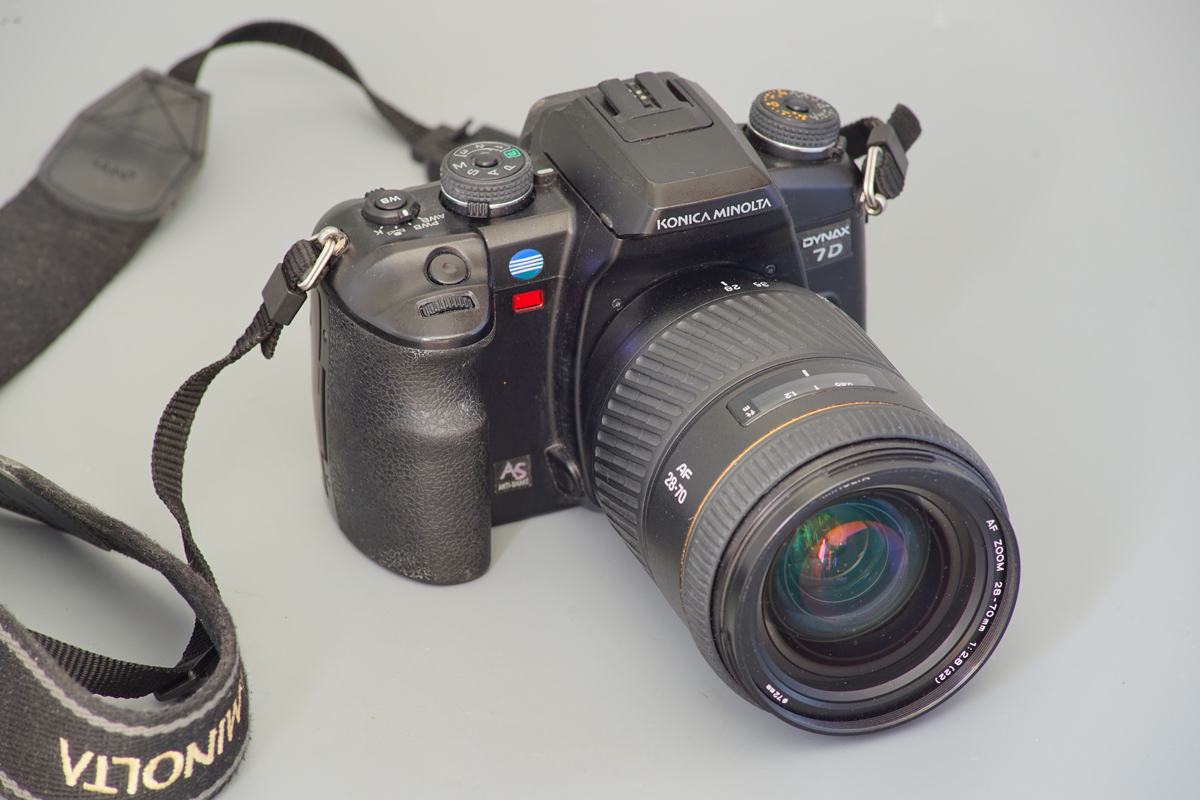
The above Minolta AF 2.8/28-70mm G was the last example missing in my collection of professional midrange zooms for the A-mount. Here they are:
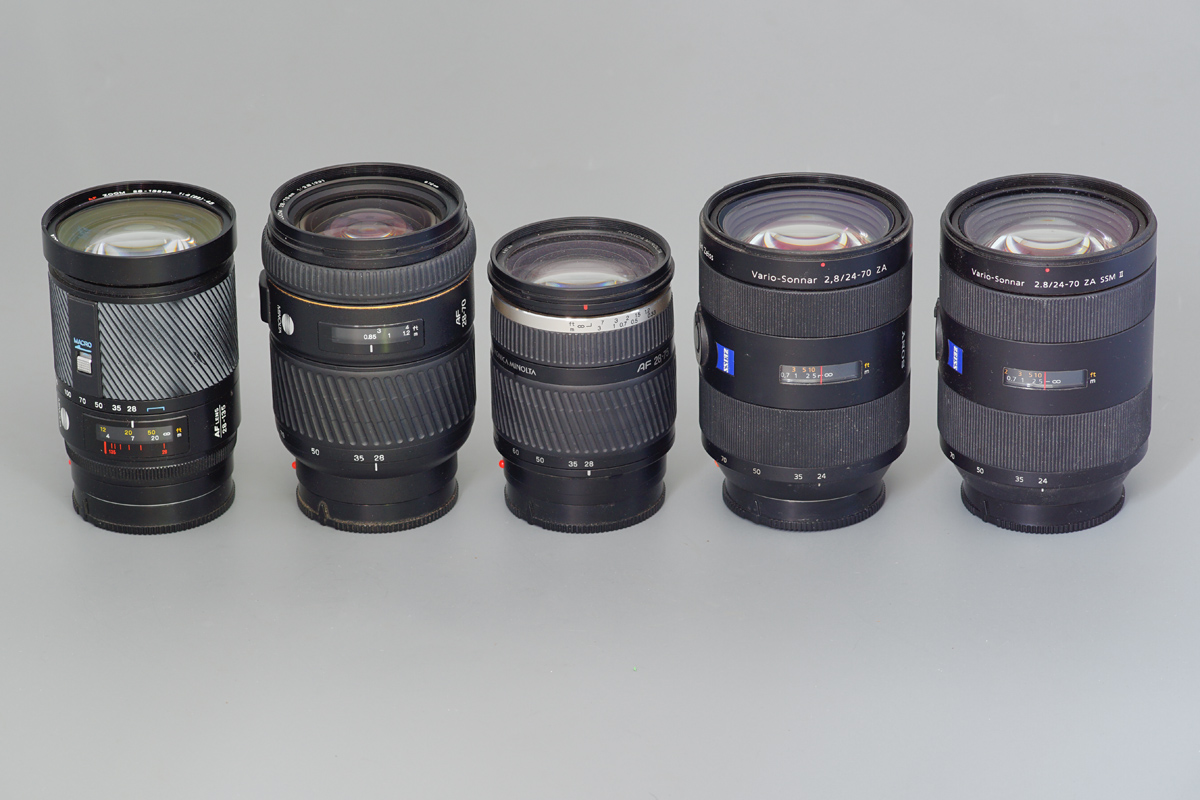
Left to right: Minolta AF 4-4.5/28-135mm, Minolta AF 2.8/28-70mm, Minolta (Tamron/Sony) 2.8/28-75mm, Sony Zeiss 2.8/24-70mm ZA, Sony (Zeiss) 2.8/24-70mm SSM II. I'll write about the performance of theses lenses later on.
Then there was a like-new Rokkor-PF 2.8/135mm - nothing special at all, but rarely to be found in such a good condition and with the corresponding quiver (is that the right English word ??), also like-new. Came for free as well ...:
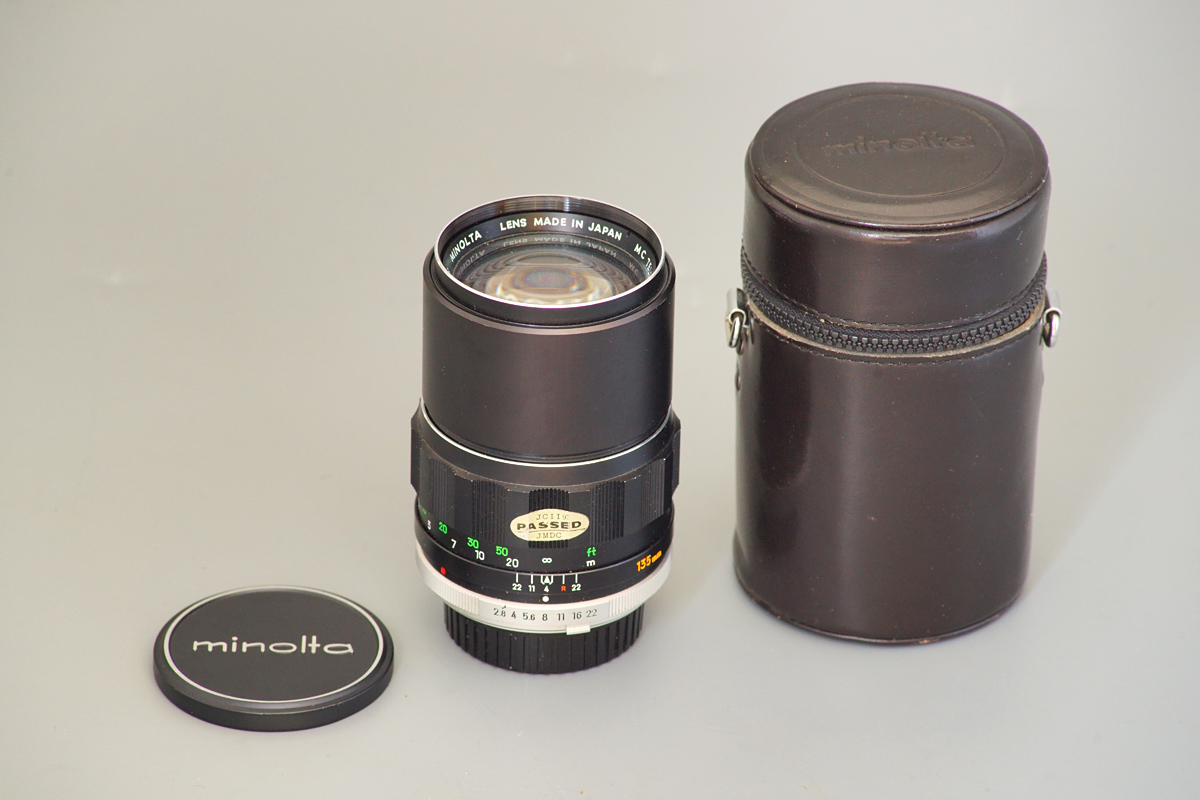
Finally an old Minolta camera for the infamous APS film system - the Vectis 25:
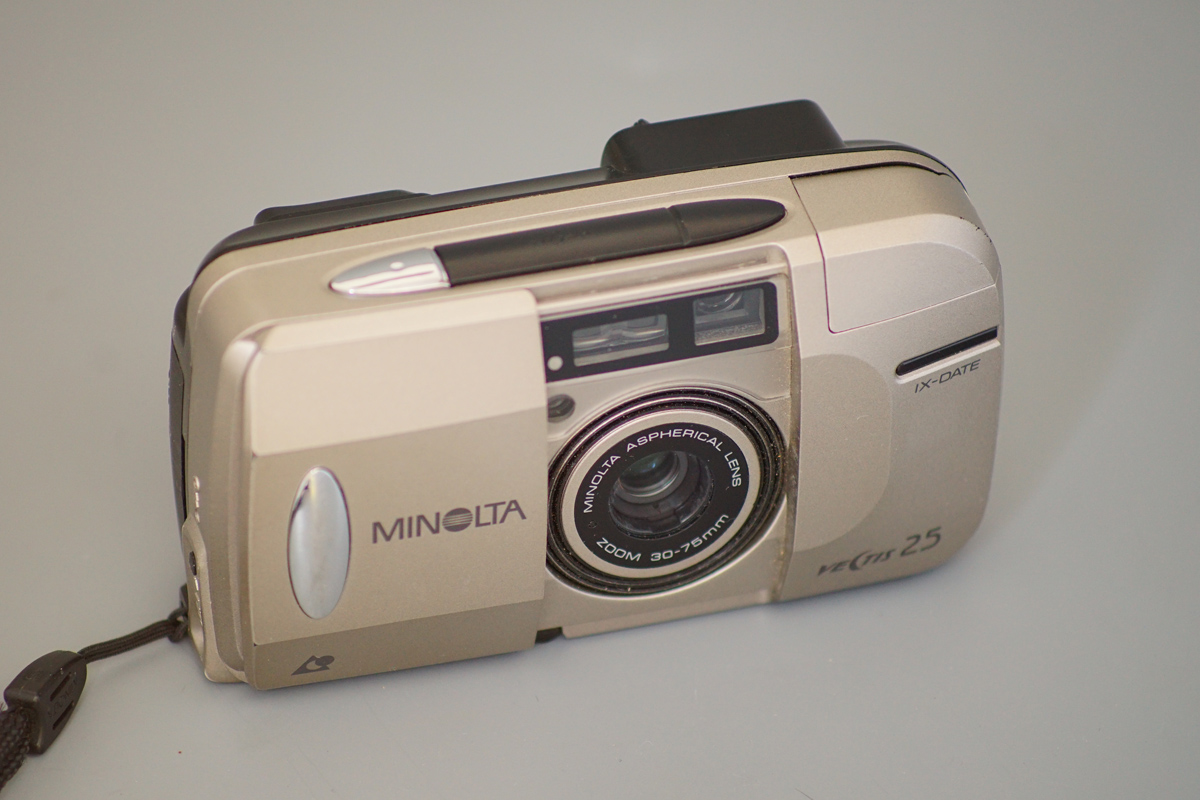
It is a nicely made small camera with an aspherical 35-75mm zoom ... nothing I would collect, but it came together with al the other stuff. Really nice to have people which are so generous ... !!
S
_________________
www.artaphot.ch
Last edited by stevemark on Sun Feb 12, 2023 3:24 am; edited 1 time in total |
|
| Back to top |
|
 |
Doc Sharptail


Joined: 23 Nov 2020
Posts: 1216
Location: Winnipeg Canada
|
 Posted: Sat Feb 11, 2023 5:40 pm Post subject: Posted: Sat Feb 11, 2023 5:40 pm Post subject: |
 |
|
Doc Sharptail wrote:
| stevemark wrote: |
Some mixed stuff from the local photo dealer - everything for free ... I hadn't been there for a few weeks, met one of their guys in town and he said he had set aside some Minolta stuff for me (knowing my connection to Minolta).
Then there was a like-new Rokkor-PF 2.8/135mm - nothing special at all, but rarely to be found in such a good condition and with the corresponding quiver (is that the right English word ??), also like-new. Came for free as well ...:
Really nice to have people which are so generous ... !!
S |
Quite a haul, and the price was certainly attractive!
That 135 fits my idea of what a classic M/F lens should be.
Quiver is as good a term as any for a cylinder case.
Some say they are fungus breeders- if they are real leather...
-D.S.
_________________
D-810, F2, FTN.
35mm f2 O.C. nikkor
50 f2 H nikkor, 50 f 1.4 AI-s, 135 f3.5 Q,
50 f2 K nikkor 2x, 28-85mm f3.5-4.5 A/I-s, 35-105 3.5-4.5 A/I-s, 200mm f4 Micro A/I, partial list.
"Ain't no half-way" -S.R.V.
"Oh Yeah... Alright" -Paul Simon |
|
| Back to top |
|
 |
stevemark

Joined: 29 Apr 2011
Posts: 4088
Location: Switzerland
|
 Posted: Sat Feb 11, 2023 6:47 pm Post subject: Posted: Sat Feb 11, 2023 6:47 pm Post subject: |
 |
|
stevemark wrote:
| Doc Sharptail wrote: |
Quite a haul, and the price was certainly attractive! |
I usually give them something for their "thank-you-box" - and they know it 
| Doc Sharptail wrote: |
| That 135 fits my idea of what a classic M/F lens should be. |
Yeah, the MC-II 2.8/135mm really feels good - its focusing still is perfectly smooth, after >50 years, the aperture as well, and the knurled metal focusing grip is very handy for manual focusing (better than the later rubber focusing IMHO). But you know that from your vintage Nikkors ...
| Doc Sharptail wrote: |
Quiver is as good a term as any for a cylinder case. |
Thanks!
| Doc Sharptail wrote: |
Some say they are fungus breeders- if they are real leather...
-D.S. |
Yep, that's why I usually throw them away, especially since they often are simpla deacaying. Not only the leather ones, but more so the foamed stuff.
S
_________________
www.artaphot.ch |
|
| Back to top |
|
 |
calvin83


Joined: 12 Apr 2009
Posts: 7584
Location: Hong Kong
|
 Posted: Tue Feb 14, 2023 8:29 am Post subject: Posted: Tue Feb 14, 2023 8:29 am Post subject: |
 |
|
calvin83 wrote:
I don't expect this lens can cover full frame but it does with some vignetting in the corner.

_________________
The best lens is the one you have with you.
https://lensfever.com/
https://www.instagram.com/_lens_fever/ |
|
| Back to top |
|
 |
Manichaean

Joined: 03 Oct 2013
Posts: 70
|
 Posted: Tue Feb 14, 2023 2:05 pm Post subject: Posted: Tue Feb 14, 2023 2:05 pm Post subject: |
 |
|
Manichaean wrote:
| stevemark wrote: |
| and with the corresponding quiver (is that the right English word ??), also like-new. |
This is a big topic rarely discussed even on this forum, but I find that the durablilty of the cases for the vintage lenses varies enormously. And the Minolta ones are among the worst, the most perishable ones. I almost never had a Minolta case from MC-early MD time which would not be heavily degraded (and I had a couple of dozens of them).
The Konica cases are, on the opposite, among the most durable ones. Most of Konica lenses I have came with cases and all of them are in a great shape, almost like new.
Canon cases are also not bad though I had one or two in bad shape. And the Pentax and Olympus OM cases are so so, there are some well preserved, there are some degraded ones but still they are much better than the Minolta lens cases. I have never seen any Nikon cases from the manual period so cannot comment on them. |
|
| Back to top |
|
 |
Doc Sharptail


Joined: 23 Nov 2020
Posts: 1216
Location: Winnipeg Canada
|
 Posted: Wed Feb 15, 2023 6:22 am Post subject: Posted: Wed Feb 15, 2023 6:22 am Post subject: |
 |
|
Doc Sharptail wrote:
I haven't seen a hard-sided nikkor case since the early 80's, and was far less than impressed with them.
The clear plexiglas bullet cases were much longer lived.
I still have a couple around here somewhere.
The current soft sided synthetic lens bags nikon now uses seem to be fine.
-D.S
_________________
D-810, F2, FTN.
35mm f2 O.C. nikkor
50 f2 H nikkor, 50 f 1.4 AI-s, 135 f3.5 Q,
50 f2 K nikkor 2x, 28-85mm f3.5-4.5 A/I-s, 35-105 3.5-4.5 A/I-s, 200mm f4 Micro A/I, partial list.
"Ain't no half-way" -S.R.V.
"Oh Yeah... Alright" -Paul Simon |
|
| Back to top |
|
 |
Ernst Dinkla

Joined: 30 Nov 2016
Posts: 411
|
 Posted: Wed Feb 15, 2023 10:47 am Post subject: Posted: Wed Feb 15, 2023 10:47 am Post subject: |
 |
|
Ernst Dinkla wrote:
| stevemark wrote: |
Some mixed stuff from the local photo dealer - everything for free ... I hadn't been there for a few weeks, met one of their guys in town and he said he had set aside some Minolta stuff for me (knowing my connection to Minolta).
Well, here we go:
First very well preserved Minolta HiMatic 9, the very best of the classic Minolta rangefinders with built-in lens:

The camera is in fully working condition, which is rather unusual; even the long exposures are working fine (1 s and 1/2s). Whether the rangefinder still is adjusted correctly I don't know (yet), of course; at least it looks clear, and both images are clearly visible. The HiMatic 9 is unusual since it has an M mode (manual), an A mode (aperture priority AE) and an S mode (shutter priority AE). Shutter speeds go from 1s to 1/500s, and the aperture from f1.7 to f16. The lens is a Rokkor-PF 1.7/45mm, thus a [6/5] design. I would expect it to be at least as good as the contemporary Rokkor PF 1.7/55mm for the SR-T SLR.
!
S |
Steven, then you better not test the two lenses for their IQ in the corners. I mean at infinity and on an FF sensor. There is a big difference in design between a rangefinder 45mm 1.7 and an SLR 55mm 1.7 lens. That 55mm lens might still depend on a retrofocus design which helps a lot for IQ on the edges. Even on film the fast double gauss fixed lenses on "compact" rangefinders do not score that well. In the center they can have a high resolution though. I have salvaged several of the 45mm 1.7, 1.8, 1.9 fixed lenses and gave them a Sony FE mount. Among them A Minolta Rokkor-PF 45mm 1.8 of the HiMatic 7. Compared to the 50-55-58mm 1.4 to 2.0 SLR lenses that I have they simply do not give that resolution in the corners. I like them a lot but for other reasons.
https://www.dpreview.com/forums/post/62537027
The double gauss derivative Biometar/Xenotar 45mm 2.8 designs should deliver better edge qualities. On film at least, as tested by a Japanese magazine a long time ago. With the loss of some resolution in the center compared to other double gauss designs. Like with the original Biometar for the Rolleiflex the design should not be considered a cheaper double gauss with its 5 elements 4 groups (which it is) but as an upgrade compared to Tessar design fixed lens rangefinders where the improvement is not in speed but in the total field resolution. Landscapes in mind I guess. Not that many fixed lens rangefinders with that lens design and the web shows conflicting data whether a particular 45mm 2.8 is 4 elements 3 groups or 5 elements 4 groups.
_________________
Met vriendelijke groet, Ernst
http://www.pigment-print.com/spectralplots/spectrumviz_1.htm
March 2017 update, 750+ inkjet media white spectral plots |
|
| Back to top |
|
 |
marcusBMG

Joined: 07 Dec 2012
Posts: 1319
Location: Conwy N Wales
|
 Posted: Sun Feb 19, 2023 2:23 pm Post subject: Posted: Sun Feb 19, 2023 2:23 pm Post subject: |
 |
|
marcusBMG wrote:
Picked up a couple of plums recently.
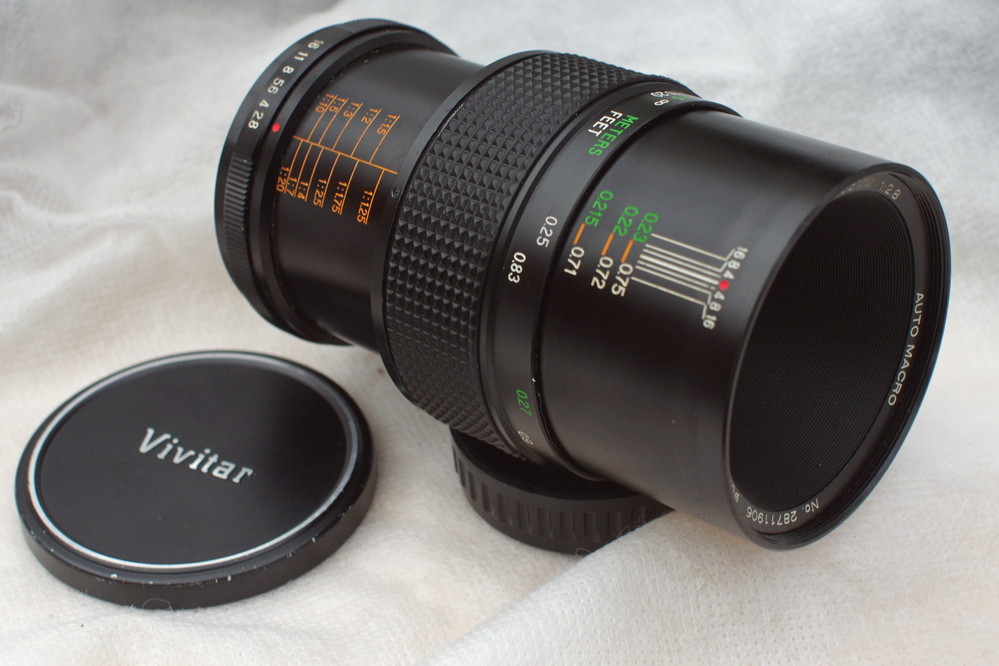
I'd been after the 55mm macro for ages.
This was pretty much LNIB with case.
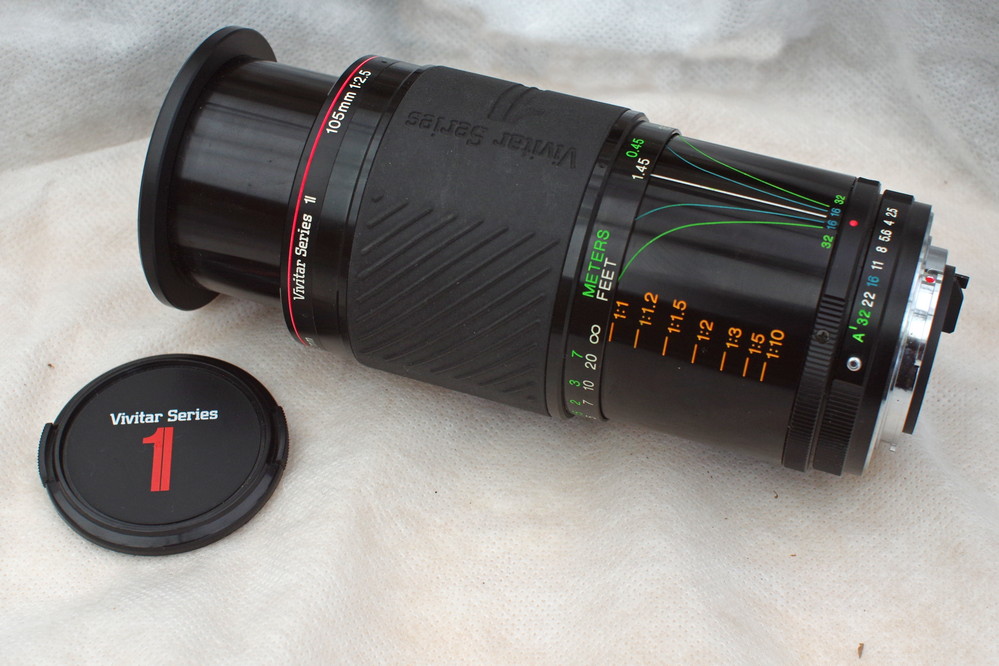
And some first pics with the 55mm f2.8. Pentax K3-ii.
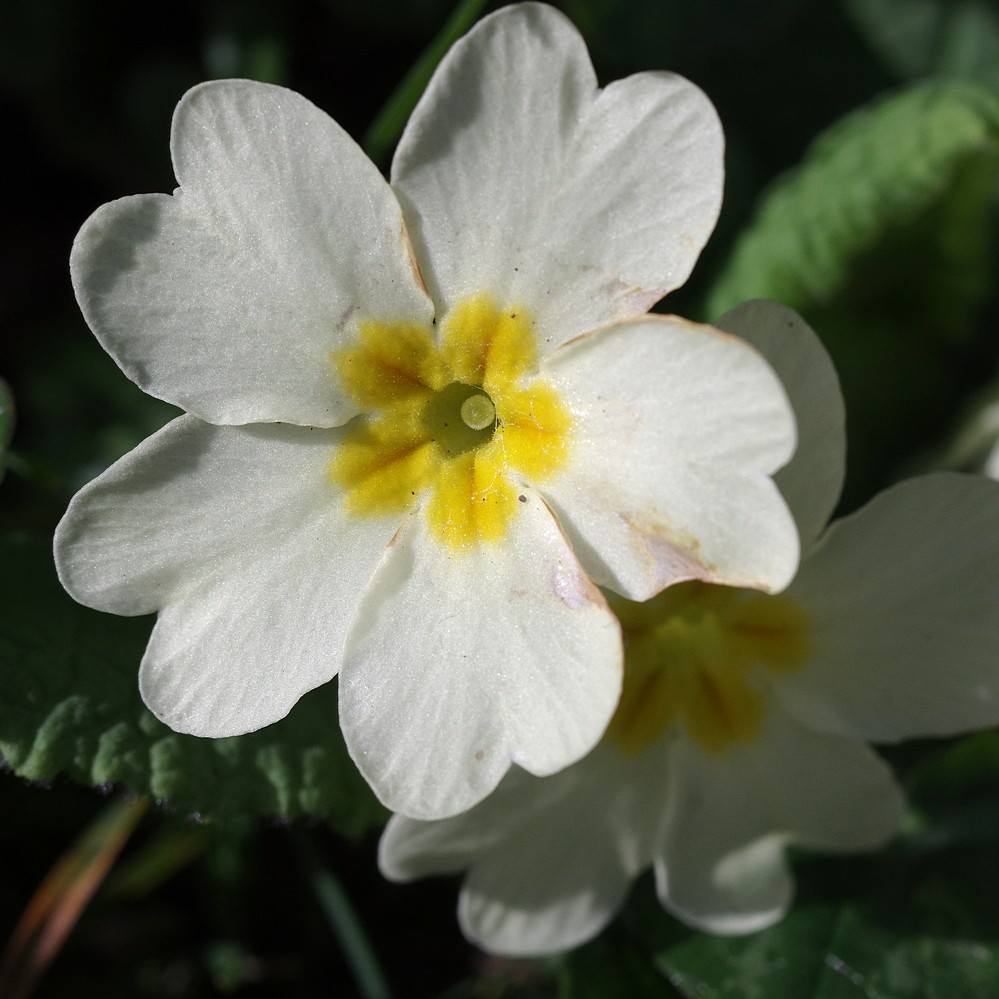

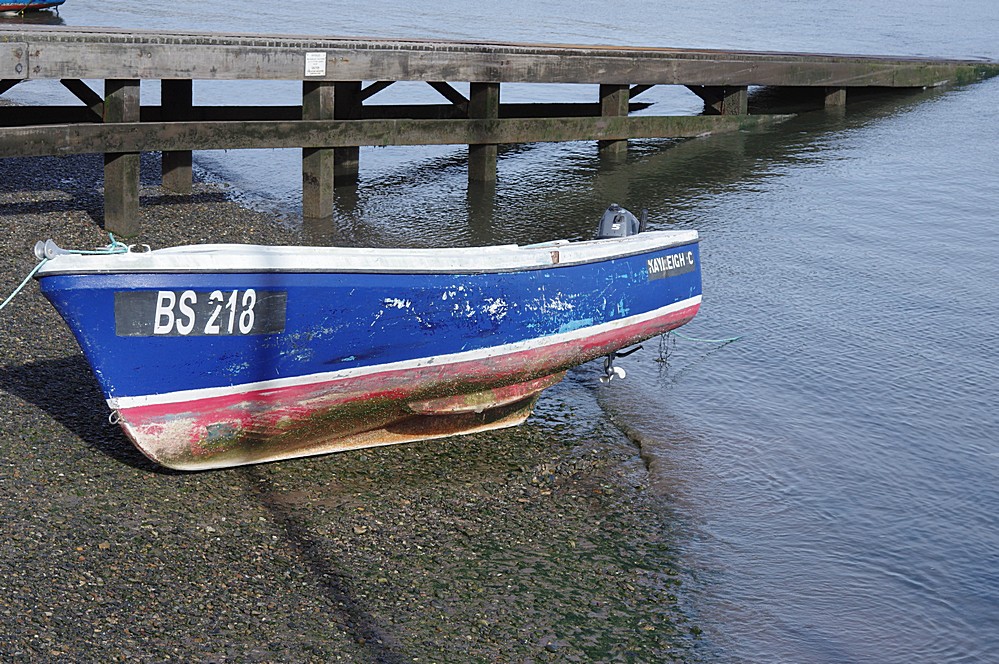
_________________
pentax ME super (retired)
Pentax K3-ii; pentax K-S2; Samsung NX 20; Lumix G1 + adapters;
Adaptall collection (proliferating!) inc 200-500mm 31A, 300mm f2.8, 400mm f4.
Primes: takumar 55mm; smc 28mm, 50mm; kino/komine 28mm f2's, helios 58mm, Tamron Nestar 400mm, novoflex 400mm, Vivitar 135mm close focus, 105mm macro; Jupiter 11A; CZJ 135mm.
A classic zoom or two: VS1 (komine), Kiron Zoomlock... |
|
| Back to top |
|
 |
DConvert


Joined: 12 Jun 2010
Posts: 921
Location: Essex UK
|
 Posted: Sun Feb 19, 2023 2:41 pm Post subject: Posted: Sun Feb 19, 2023 2:41 pm Post subject: |
 |
|
DConvert wrote:
I spotted an Industar 10 at the car boot sale this morning, in a tray of plumbing fittings. I was happy to pay their asking price of 50p 
Everything seems to work fine on it, but the glass is a little dirty (so not up to the same standard as those currently selling on e-bay for £75) most of this cleaned off in less than a minute.

Last edited by DConvert on Mon Feb 20, 2023 12:20 pm; edited 1 time in total |
|
| Back to top |
|
 |
papasito

Joined: 09 Jan 2015
Posts: 1663
|
 Posted: Sun Feb 19, 2023 3:54 pm Post subject: Posted: Sun Feb 19, 2023 3:54 pm Post subject: |
 |
|
papasito wrote:
| Ernst Dinkla wrote: |
| stevemark wrote: |
Some mixed stuff from the local photo dealer - everything for free ... I hadn't been there for a few weeks, met one of their guys in town and he said he had set aside some Minolta stuff for me (knowing my connection to Minolta).
Well, here we go:
First very well preserved Minolta HiMatic 9, the very best of the classic Minolta rangefinders with built-in lens:

The camera is in fully working condition, which is rather unusual; even the long exposures are working fine (1 s and 1/2s). Whether the rangefinder still is adjusted correctly I don't know (yet), of course; at least it looks clear, and both images are clearly visible. The HiMatic 9 is unusual since it has an M mode (manual), an A mode (aperture priority AE) and an S mode (shutter priority AE). Shutter speeds go from 1s to 1/500s, and the aperture from f1.7 to f16. The lens is a Rokkor-PF 1.7/45mm, thus a [6/5] design. I would expect it to be at least as good as the contemporary Rokkor PF 1.7/55mm for the SR-T SLR.
!
S |
Steven, then you better not test the two lenses for their IQ in the corners. I mean at infinity and on an FF sensor. There is a big difference in design between a rangefinder 45mm 1.7 and an SLR 55mm 1.7 lens. That 55mm lens might still depend on a retrofocus design which helps a lot for IQ on the edges. Even on film the fast double gauss fixed lenses on "compact" rangefinders do not score that well. In the center they can have a high resolution though. I have salvaged several of the 45mm 1.7, 1.8, 1.9 fixed lenses and gave them a Sony FE mount. Among them A Minolta Rokkor-PF 45mm 1.8 of the HiMatic 7. Compared to the 50-55-58mm 1.4 to 2.0 SLR lenses that I have they simply do not give that resolution in the corners. I like them a lot but for other reasons.
https://www.dpreview.com/forums/post/62537027
The double gauss derivative Biometar/Xenotar 45mm 2.8 designs should deliver better edge qualities. On film at least, as tested by a Japanese magazine a long time ago. With the loss of some resolution in the center compared to other double gauss designs. Like with the original Biometar for the Rolleiflex the design should not be considered a cheaper double gauss with its 5 elements 4 groups (which it is) but as an upgrade compared to Tessar design fixed lens rangefinders where the improvement is not in speed but in the total field resolution. Landscapes in mind I guess. Not that many fixed lens rangefinders with that lens design and the web shows conflicting data whether a particular 45mm 2.8 is 4 elements 3 groups or 5 elements 4 groups. |
In 2008/2009 in this forum I read a review made in Japan about different RF lenses of some brands ( Konica, Minolta, Canon, Yashica, Olympus) The better score was for the Yashinon 45/1,8 (for the Lynx 5000E). |
|
| Back to top |
|
 |
kiddo

Joined: 29 Jun 2018
Posts: 1275
|
 Posted: Sun Feb 19, 2023 6:11 pm Post subject: Posted: Sun Feb 19, 2023 6:11 pm Post subject: |
 |
|
kiddo wrote:
Mamiya Sekor SX 105mm 2.8 and Mamiya Sekor SX 200mm 3.5 , this last one I could only remove rear group and first front element, but needs a full CLA but don't know how to go further on , iris is blocked, focus is sandy , but glass and body is not to bad . |
|
| Back to top |
|
 |
papasito

Joined: 09 Jan 2015
Posts: 1663
|
 Posted: Mon Feb 20, 2023 3:01 am Post subject: Posted: Mon Feb 20, 2023 3:01 am Post subject: |
 |
|
papasito wrote:
| kiddo wrote: |
| Mamiya Sekor SX 105mm 2.8 and Mamiya Sekor SX 200mm 3.5 , this last one I could only remove rear group and first front element, but needs a full CLA but don't know how to go further on , iris is blocked, focus is sandy , but glass and body is not to bad . |
The 105/2,8 is a rare lens.
I never see one in the real world.
Actually have SX lenses: 55/1,8, 55/1,4, 85/2,8, 135/2,8 and 200/3,5. All of them very good lenses. |
|
| Back to top |
|
 |
caspert79


Joined: 31 Oct 2010
Posts: 3225
Location: The Netherlands
|
 Posted: Mon Feb 20, 2023 9:09 am Post subject: Posted: Mon Feb 20, 2023 9:09 am Post subject: |
 |
|
caspert79 wrote:
| papasito wrote: |
| kiddo wrote: |
| Mamiya Sekor SX 105mm 2.8 and Mamiya Sekor SX 200mm 3.5 , this last one I could only remove rear group and first front element, but needs a full CLA but don't know how to go further on , iris is blocked, focus is sandy , but glass and body is not to bad . |
The 105/2,8 is a rare lens.
I never see one in the real world.
Actually have SX lenses: 55/1,8, 55/1,4, 85/2,8, 135/2,8 and 200/3,5. All of them very good lenses. |
I used to have the Rolleinar 105/2.8 which I think is the same lens. Not a bad lens.
_________________
For Sale:
Steinheil Auto D Tele Quinar 135mm f/2.8 (Exa)
ISCO Isconar 100mm f/4 (Exa)
Steinheil Cassarit 50mm f/2.8 M39 (Paxette)
I'm always interested in trading lenses! |
|
| Back to top |
|
 |
Ernst Dinkla

Joined: 30 Nov 2016
Posts: 411
|
 Posted: Mon Feb 20, 2023 1:56 pm Post subject: Posted: Mon Feb 20, 2023 1:56 pm Post subject: |
 |
|
Ernst Dinkla wrote:
[quote="papasito"][quote="Ernst Dinkla"]
| stevemark wrote: |
In 2008/2009 in this forum I read a review made in Japan about different RF lenses of some brands ( Konica, Minolta, Canon, Yashica, Olympus) The better score was for the Yashinon 45/1,8 (for the Lynx 5000E). |
Probably the same document I (google) translated a year ago and organised the test results off. There is vagueness about the test's conditions, whether relying on the rangefinder linking accuracy as well or focused and measured optically in the film gate one way or another. It has a number for the center at wide open and at 5.6 and an average (of what?) to indicate the overall resolution at wide open and 5.6.
I simply added all the numbers together and with a 45mm focal lengths the first five were the Fujica 35-SE, Olympus ACE (exchangeable lens though), Yashica 35, Konica Electron, Yashica Lynx 5000E. In that order. I have that Yashinon of the last one and some identical lenses of Fujica and Konica models, among more. As I suspected that both the test conditions and lens sample variation played a roll I did not go pure by the camera type but by identical lens descriptions for buying defect donor cameras.
_________________
Met vriendelijke groet, Ernst
http://www.pigment-print.com/spectralplots/spectrumviz_1.htm
March 2017 update, 750+ inkjet media white spectral plots |
|
| Back to top |
|
 |
papasito

Joined: 09 Jan 2015
Posts: 1663
|
 Posted: Mon Feb 20, 2023 3:41 pm Post subject: Posted: Mon Feb 20, 2023 3:41 pm Post subject: |
 |
|
papasito wrote:
| caspert79 wrote: |
| papasito wrote: |
| kiddo wrote: |
| Mamiya Sekor SX 105mm 2.8 and Mamiya Sekor SX 200mm 3.5 , this last one I could only remove rear group and first front element, but needs a full CLA but don't know how to go further on , iris is blocked, focus is sandy , but glass and body is not to bad . |
The 105/2,8 is a rare lens.
I never see one in the real world.
Actually have SX lenses: 55/1,8, 55/1,4, 85/2,8, 135/2,8 and 200/3,5. All of them very good lenses. |
I used to have the Rolleinar 105/2.8 which I think is the same lens. Not a bad lens. |
Yes it's a lens made in japan by mamiya for rollei |
|
| Back to top |
|
 |
stevemark

Joined: 29 Apr 2011
Posts: 4088
Location: Switzerland
|
 Posted: Mon Feb 20, 2023 11:55 pm Post subject: Posted: Mon Feb 20, 2023 11:55 pm Post subject: |
 |
|
stevemark wrote:
| Ernst Dinkla wrote: |
Steven, then you better not test the two lenses for their IQ in the corners. |
I certainly won't do that. I wouldn't be able to correctly remove the lens from the HiMatic 9 ...!
| Ernst Dinkla wrote: |
| I mean at infinity and on an FF sensor. There is a big difference in design between a rangefinder 45mm 1.7 and an SLR 55mm 1.7 lens. That 55mm lens might still depend on a retrofocus design which helps a lot for IQ on the edges. Even on film the fast double gauss fixed lenses on "compact" rangefinders do not score that well. |
I am fully aware of that fact. Many moons ago - when the Leica M9 was introduced - I checked its (M9) and the A7 performance with critical superwides (Biogon 15mm, C-Biogon 21mm, Summilux 35mm). The result was clear: My Sony A900 plus Zeiss 2.8/16-35mm did outperform them all, either regarding resolution (A7) or regarding sensor performance (M9). Actually it was pretty shocking how bad the M9 colors were compared to the A900.
S
_________________
www.artaphot.ch |
|
| Back to top |
|
 |
eggplant


Joined: 27 May 2020
Posts: 517
|
 Posted: Tue Feb 21, 2023 10:12 am Post subject: Posted: Tue Feb 21, 2023 10:12 am Post subject: |
 |
|
eggplant wrote:
| Ernst Dinkla wrote: |
Steven, then you better not test the two lenses for their IQ in the corners. I mean at infinity and on an FF sensor. There is a big difference in design between a rangefinder 45mm 1.7 and an SLR 55mm 1.7 lens. That 55mm lens might still depend on a retrofocus design which helps a lot for IQ on the edges. Even on film the fast double gauss fixed lenses on "compact" rangefinders do not score that well. In the center they can have a high resolution though. I have salvaged several of the 45mm 1.7, 1.8, 1.9 fixed lenses and gave them a Sony FE mount. Among them A Minolta Rokkor-PF 45mm 1.8 of the HiMatic 7. Compared to the 50-55-58mm 1.4 to 2.0 SLR lenses that I have they simply do not give that resolution in the corners. I like them a lot but for other reasons.
https://www.dpreview.com/forums/post/62537027
The double gauss derivative Biometar/Xenotar 45mm 2.8 designs should deliver better edge qualities. On film at least, as tested by a Japanese magazine a long time ago. With the loss of some resolution in the center compared to other double gauss designs. Like with the original Biometar for the Rolleiflex the design should not be considered a cheaper double gauss with its 5 elements 4 groups (which it is) but as an upgrade compared to Tessar design fixed lens rangefinders where the improvement is not in speed but in the total field resolution. Landscapes in mind I guess. Not that many fixed lens rangefinders with that lens design and the web shows conflicting data whether a particular 45mm 2.8 is 4 elements 3 groups or 5 elements 4 groups. |
I have a great condition Yashica Lynx 14E sitting around with its 45mm f1.4.
For a good while a Sony E adapter was being made for these, decently priced, and I put it off, only to find it's not being produced anymore and only sold at silly prices.
Which is a shame as I was looking forward to that lens... yes it could very well be crap, and maybe not so unique, but is unique enough amongst fixed lens rangefinder lenses for me..
_________________
UK
Last edited by eggplant on Tue Feb 21, 2023 10:19 am; edited 1 time in total |
|
| Back to top |
|
 |
eggplant


Joined: 27 May 2020
Posts: 517
|
 Posted: Tue Feb 21, 2023 10:18 am Post subject: Posted: Tue Feb 21, 2023 10:18 am Post subject: |
 |
|
eggplant wrote:
| marcusBMG wrote: |
Picked up a couple of plums recently.
I'd been after the 55mm macro for ages.
This was pretty much LNIB with case.

|
Interesting - I hadn't seen a Vivitar macro with the later Series 1 red ring and the grip style. Although I should've assumed it existed..
I wonder if the optical design has changed. The body style is clearly in the same vein as some of the 70-210mm f2.8-4 versions. But I'm unsure if they tweaked the optical design between those. The macro lens would have less of a reason to be changed.
_________________
UK |
|
| Back to top |
|
 |
|
|
